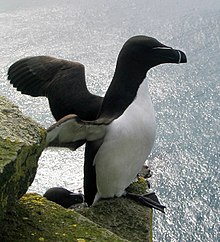Razorbills
| Razorbill | |
|---|---|
 |
|
| At Westfjords peninsula, Iceland
Pair of Razorbills calling, recorded on Skokholm
|
|
| Scientific classification | |
| Kingdom: | Animalia |
| Phylum: | Chordata |
| Class: | Aves |
| Order: | Charadriiformes |
| Suborder: | Lari |
| Family: | Alcidae |
| Genus: |
Alca Linnaeus, 1758 |
| Species: | A. torda |
| Binomial name | |
|
Alca torda Linnaeus, 1758 |
|
The razorbill (Alca torda) is a colonial seabird that comes to land only to breed. This agile bird chooses one partner for life; females lay one egg per year. Razorbills nest along coastal cliffs in enclosed or slightly exposed crevices. The parents spend equal amounts of time incubating. Once the chick has hatched, the parents take turns foraging for their young and sometimes fly long distances before finding prey.
The razorbill is primarily black with a white underside. The male and female are identical in plumage; however, males are generally larger than females. In 1918, the razorbill was protected in the United States by the Migratory Bird Treaty Act. Presently, the major threat for the population is the destruction of breeding sites.
The razorbill is in the genus Alca of the family Alcidae. It is closest living relative of the great auk (Pinguinis impennis), which is now extinct. The clade Alcini also includes the common murre (Uria aalge), the thick-billed murre (Uria lomvia) and the dovekie (Alle alle). The genus name Alca is from Norwegian Alke, and torda is from törd a Gotland Swedish dialect word. Both terms refer to this species.
There are two subspecies of razorbill recognized by the American Ornithologists' Union. Alca torda torda, named by Linnaeus in 1758, occurs in the Baltic and White Seas, Norway, Bear Island, Iceland, Greenland, and eastern North America. Alca torda islandica was named by C.L. Brehm in 1831 and occurs throughout the Ireland, Britain and northwestern France. The two subspecies differ slightly in bill measurements. A third subspecies, Alca torda pica, is no longer recognized because the distinguishing characteristic, an additional furrow in the upper mandible, is now known to be age-related.
...
Wikipedia

